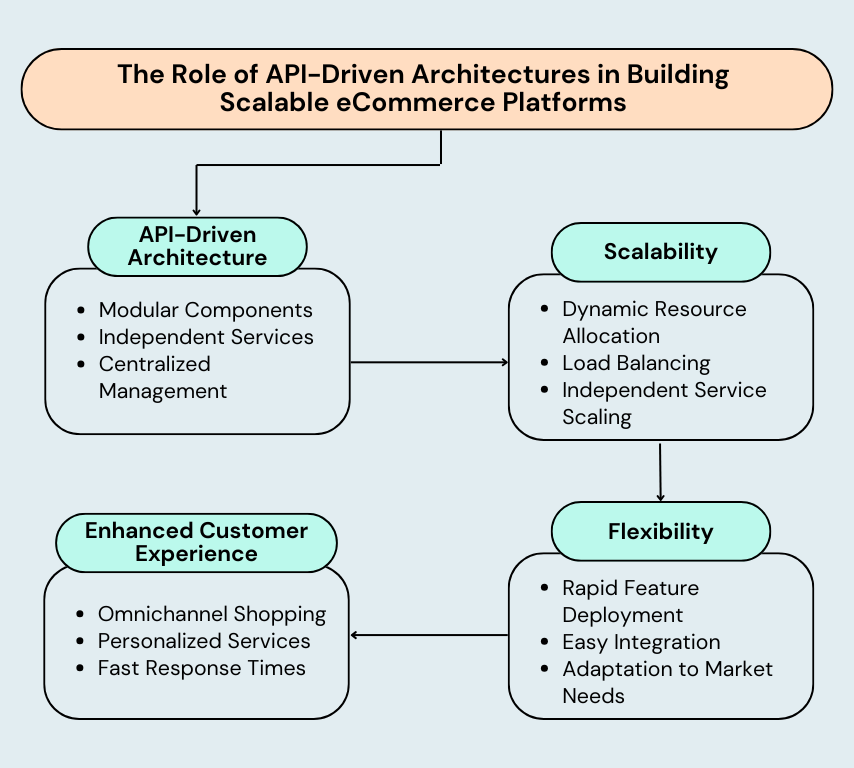AI Powered Product Recommendations : Revolutionizing eCommerce in 2025


With the expansion of eCommerce, companies face the challenge of ensuring their platforms can support millions of users, varying traffic levels, and changing customer demands. Older systems, while effective in the past, often struggle to keep up, leading to slower performance, limited adaptability, and high integration costs. API-driven architecture provide a modern solution by enabling modular designs, easy third-party integrations, and faster feature updates.
This approach transforms outdated systems into efficient, scalable platforms. In this article, we will explore how API-driven architecture support scalable eCommerce solutions.
API-driven architecture offers a clear framework for building and delivering web services, ensuring smooth communication between APIs and system components like databases, applications, and external systems. It provides a set of guidelines for creating web services, focusing on modularity and adaptability. APIs in this setup are not just tools for communication but essential elements that shape how systems function and grow.
In eCommerce, API-driven architecture is crucial for building platforms that can easily scale and adapt. It uses different types of APIs—public (for external tools like payment gateways), private (for internal processes), and partners (for collaborations)—to ensure everything runs smoothly. Features like reusability, scalability, and decentralized control make it ideal for handling large traffic and complex workflows. A report by JPMorgan Chase highlights the benefits of modular and API-driven architectures in improving cost elasticity and operational efficiency.
Moving from traditional systems to API-driven architecture is a major change in how eCommerce platforms are built. Unlike older systems, which are harder to scale, API-driven models support fast development, easy integrations, and strong performance. This allows eCommerce platforms to keep up with changing demands and grow as needed.
Here are the benefits of API-driven architectures for eCommerce:
The key components of API-driven architecture include:
Developing a scalable eCommerce platform with an API-driven architecture emphasizes flexibility, boosts performance, and enables future growth. So, how can you build an eCommerce platform using API-driven architecture? Here’s the basic step that you can follow:
Start by breaking your platform into smaller, independent services, like product catalog, payment processing, and order management. In this manner, each component can be advanced, expanded, and managed independently without affecting the others.
Configure an API gateway to manage all incoming requests. It guarantees efficient routing of everything, balances the workload, manages authentication, and oversees the services. This ensures your platform operates seamlessly.
APIs allow effortless connections with external services such as payment processors, shipping companies, and CRM platforms. This allows you to incorporate new features or modify services without impacting your core platform.
To improve performance, save data that is frequently accessed, like product details or user profiles. This reduces the load on your servers and improves the speed for your users.
Leverage cloud services and features like serverless computing or elastic scaling to automatically adjust your resources as demand rises. This guarantees that your platform can grow without additional effort.
Safeguard your platform through robust security measures. Utilize OAuth, API tokens, and encryption to ensure data protection and secure user transactions.
Implement tools to observe your system’s performance and analyze the usage of APIs. This assists you in resolving issues and enhancing performance consistently, ensuring your platform remains optimized.

The chart diagram illustrates how API-driven architectures contribute to building scalable eCommerce platforms.
To build a scalable API-driven eCommerce platform, start by modularizing services into independent components for easy scaling. You can use an API gateway for efficient traffic management, authentication, and load balancing. You can implement caching to speed up data access, prioritize security with measures like OAuth and encryption, and leverage cloud infrastructure for elastic scaling. Finally, It is better to consistently monitor platform performance and optimize it using real-time data to ensure seamless user experiences.
API-driven architectures are key to building scalable eCommerce platforms. They offer flexibility, faster development, and easy integration. By using microservices, API gateways, and cloud technologies, you can adapt to growth, improve performance, and deliver a strong user experience. This helps your platform succeed in a constantly changing market.
RBM Software helps businesses build scalable eCommerce platforms using API-driven architectures. Our offshore teams provide cost-effective solutions without compromising quality. Contact us for a free consultation to optimize your platform.